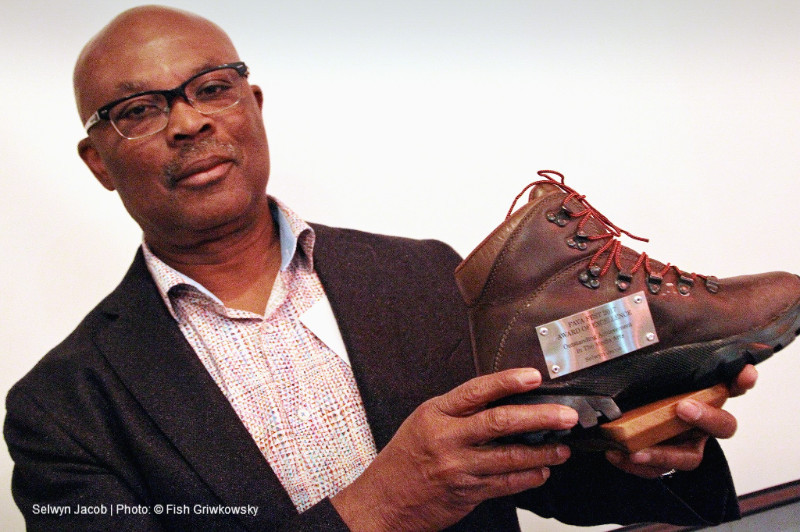I’ve often said to myself, life is stranger than fiction. On the news we’re often given clear evidence of that. The stories are often thirty seconds long before it’s onto the next one. They are gripping and spellbinding. They leave you with more questions than answers. Even still, most of our interests are soon absorbed into the next news story. Luckily, somebody is still mulling over the last story and debating the best way to begin collecting the details. In the eyes of a filmmaker, that last story might very well have the elements of his next documentary. If you’re curious to know what that process is like, Selwyn Jacob a.k.a. NFB producer was happy to ‘spill the beans.’ 
Selwyn Jacob has produced approx. fifty documentaries. On April 22 in Edmonton, he received the Outstanding Achievement Award for his years of contribution to the media arts and body of work. I had the amazing privilege to speak with him at the National Film Board location in downtown Vancouver. Their amazing and brilliant publicist Katja De Bock invited me down. She was so kind in introducing me to the very pleasant staff working tirelessly behind the scenes. Once meeting and sitting down with Selwyn, we got to the meat and potatoes as well as the spilled beans.
Selwyn Jacob has wanted to know how to make films since he was twelve years old. That was his first exposure to cinema living in Trinidad. As he grew into a young man and began to consider college, there were no options for film studies offered in the curriculum. He’d have to wait till he was in his early twenties before discovering an article in Ebony Magazine. It was about a cinematographer and his journey through film school. His dreams had been answered. The idea had been seeded to research his film studies options. He elected to move to Edmonton for his undergraduate work before earning his Masters in California. The film study program was set up by the Hollywood business sector and designed to create Hollywood style filmmakers. Once earning his degree, Selwyn returned to Alberta and quickly realized the film industry was quite bleak. Having earned a bachelor in education prior to his film studies he was able to find employment through teaching. After speaking with a close friend it was suggested he begin making documentaries in the summer. This would allow him to get his name out there and begin establishing himself as a filmmaker.
His first documentary was about a large migration of blacks moving to Northern Alberta. The story was personal and interesting to him. He knew most people would find the story interesting because of the location and the black community living there. After making a few more documentaries Selwyn tells me he began to feel a level of satisfaction.
“A documentary has the ability to move you more emotionally than a movie. It deals with real people and real experiences. A movie is created for entertainment purposes. In comparison, a documentary is a story that has been overlooked by mainstream filmmakers.”
Selwyn is often surprised to hear people make the statement after watching each documentary.
“I didn’t know that happened.”
He takes that as his cue, he is on the path of a good story. Once he has a personal interest/connection in a subject or story, he becomes fascinated and wants to read about it, and tell the public about it.
“Although I may find the story intriguing, my perspective is not always in sync with the broadcaster. After I pitch it they sometimes fail to see the same value. This should never be a deterrent. I have gone forward with productions because the story was important enough to me. I always offer the same advice to others. I may be one of the people to do the rejecting someday because it doesn’t appeal, they don’t have the finances or otherwise. You should still make your film and follow your passion.”
When a filmmaker approaches Selwyn for the prospect of producing their film, chances are they’ve already met. Selwyn attends multiple festivals/events throughout the year and establishes many relationships along the way. He has his finger on the pulse and his eye on the screen.
“Once a production has been given the green light and the process of development moves forward, what would be some of those initial steps you would be taking with the filmmaker?”
“We’d first prepare a treatment, create and establish a budget and timeline. After that we’d sit down and go over the scope of the story as well as determine the sound, camera and editing crew. At times my boss, the executive producer will sit in on discussions.”
“What are some of the larger costs associated with each production?”
“Travelling and accommodations for the crew and the subject’s can be costly. As a producer you are always finding ways to keep costs down by sometimes flying the subject in as opposed to the crew flying to them. Another large expense is obtaining stock/archival footage and buying the licensing for it for a period of time. If you want to use the stock footage after five years, you’ll have to renegotiate for more licensing.”
There are multiple sources that carry stock footage. The Olympic committee, the networks, NFB and one of the wealthiest sources, Getty Images. When the credits roll, you can sometimes see twenty different sources being mentioned.
“Is there any past films you’ve done that you are most proud of?”
“Looking back, a film called The Saint From North Battleford is one I’m quite pleased with. It’s a story about a US family that moves up to the prairies. Their son plays high school football and later attends a College in Washington. He is then drafted for the New Orleans Saints and wins rookie of the year. It’s the kind of story you would find interesting even if you don’t follow football. It was very well received and paved the way into TIFF. It was the first time I felt I had moved up the upper echelon of Canadian film. It also marked the first time I had brought a crew to a foreign country without incident.”
Selwyn mentions one more documentary that holds a special memory, Mighty Jerome. It is the story of Harry Jerome, an amazing Olympic track and field athlete raised in BC. A special athlete that inspired so many, Harry Jerome unfortunately passed away from a brain aneurism at the age of forty-two. His legacy lives on and thanks to the documentary celebrating his life and contribution to sports, more of the public are aware of his amazing story. In Toronto there is a Harry Jerome Award given to outstanding athletes as well as The Hary Jerome Classic. An International track and field meet held every year in Vancouver. The film won a regional Emmy and was broadcast across the PBS network.
It is safe to say that Selwyn Jacob has left his mark in the documentary arena. The next time you hear a snippet of an amazing story, someone like Selwyn may be listening and taking notes to answer the why, when and how it happened. We at Hollywood North Magazine will have our pulse on his pen.

